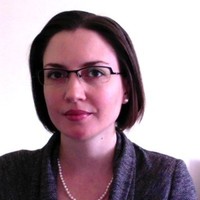
Julia M. Robinson-Surry
- Courses9
- Reviews20
- School: St. John's University
- Campus:
- Department: Chemistry
- Email address: Join to see
- Phone: Join to see
-
Location:
8000 Utopia Parkway
Queens, NY - 11439 - Dates at St. John's University: December 2014 - June 2017
- Office Hours: Join to see
Biography
St. John's University - Chemistry
Resume
2014
St. John's University
New York University
Queens
NY
Courses: CHE 2230/2240 (Organic Chemistry I and II for Biology Majors)
CHE 1120/1130 (Intro to General & Organic Chemistry for Pharm.D. and Physician's Assistant Majors)
CHE 3260 (Advanced Organic Chemistry III for Chemistry and Biology Majors).\n\nResponsibilities: CHE 1120 and 1130 Course Coordinator
CHE 1122R Recitation Coordinator.
Visiting Assistant Professor of Chemistry
St. John's University
Tandon School of Engineering
Courses: CM-UY 1004 (General Chemistry for Engineers)
CM-UY 2213/2223 (Organic Chemistry I and Organic Chemistry II)
CM-UY 3514 (Analytical Chemistry)
CM-UY 2102 (Molecular Modeling in Chemistry)\n\nResponsibilities: General Chemistry Manager (Coordinating Adjunct Instructors and TAs)
Industry Assistant Professor
New York University
Thesis title: Pericyclc Reactions in Organic Synthesis\n\nDirected 2 international visiting scientists from Daiichi-Sankyo Co. in the development of an efficient new synthetic process leading to a primary author publication in a top peer-reviewed journal.\n\nCollaborated with chemical engineers on environmentally-benign methods for pharmaceutical synthesis.\n\nCo-author of 3 peer-reviewed publications in international journals; presented research in 3 public lectures.
Massachusetts Institute of Technology
NYU Tandon School of Engineering
Brooklyn
NY
Industry Associate Professor
Designed lecture handouts
problem sets
and exams for a graduate level organic synthesis class.\n\nConducted recitations for undergraduate organic chemistry classes; tutored individual students.
Massachusetts Institute of Technology
New York University
Brooklyn
NY
Industry Associate Professor
2011
Bard HS Early College Queens
NYU Tandon School of Engineering
Long Island City
NY
Courses: \n* General Chemistry with Lab\n* Organic Chemistry I and II with Lab\n* Advanced Organic Chemistry Tutorial\n\nLeadership:\n* UFT Co-Chapter Leader\n* Science Department Representative to the School Leadership Team and Executive Committee\n* College Transfer Advisor \n* New Teacher Mentor
Assistant Professor of Chemistry
Bard HS Early College Queens
2006
Ph.D.
Organic Chemistry
Graduate Women at MIT
Chemistry Outreach Program
Massachusetts Institute of Technology
2002
BA
Chemistry
Phi Beta Kappa
4
A [4+4] annulation strategy for the synthesis of eight-membered carbocycles is reported that proceeds via a cascade involving two pericyclic processes. In the first step
the [4+2] cycloaddition of a conjugated enyne with an electron-deficient cyclobutene generates a strained six-membered cyclic allene that isomerizes to the corresponding 1
3-cyclohexadiene. In the second step
this bicyclo[4.2.0]octa-2
4-diene intermediate undergoes thermal or acid-promoted 6-electron electrocyclic ring opening to furnish a 2
6-cyclooctatrienone. The latter transformation represents the first example of the promotion of 6-electron electrocyclic ring opening reactions by acid.
A [4 + 4] Annulation Strategy for the Synthesis of Eight-membered Carbocycles Based on Intramolecular Cycloadditions of Conjugated Enynes
Takafumi Kitawaki
Katsu Okano
Takeo Sakai
A formal
metal-free
[2 + 2 + 2] cycloaddition strategy is described based on a cascade of two pericyclic processes. The first step involves an intramolecular propargylic ene reaction of a 1
6-diyne to generate a vinylallene
which then reacts in an inter- or intramolecular Diels−Alder reaction with an alkenyl or alkynyl dienophile. Reactions involving unsymmetrical alkenyl and alkynyl dienophiles proceed with good to excellent regioselectivity
and the diastereoselectivity in the Diels−Alder step is also high
with endo cycloadducts produced as the exclusive products of the reaction. In the case of alkynyl dienophiles
[4 + 2] cycloaddition initially generates an isotoluene-type intermediate that isomerizes to the isolated aromatic product upon exposure to a catalytic amount of DBU at room temperature. The mechanism of several earlier fully intramolecular related transformations have been shown to involve an analogous process rather than the diradical-mediated pathways proposed previously.
Formal [2 + 2 + 2] Cycloaddition Strategy Based on an Intramolecular Propargylic Ene Reaction/Diels-Alder Cycloaddition Cascade
Jefferson Tester
Rocco Ciccolini
Xiao Yin Mak
Supercritical carbon dioxide can be employed as an environmentally friendly alternative to conventional organic solvents for the synthesis of a variety of carboxylic amides. The addition of amines to ketenes generated in situ via the retro-ene reaction of alkynyl ethers provides amides in good yield
in many cases with ethylene or isobutylene as the only byproducts of the reaction. Reactions with ethoxy alkynes are performed at 120−130 °C
whereas tert-butoxy derivatives undergo the retro-ene reaction at 90 °C. With the exception of primary
unbranched amines
potential side reactions involving addition of the amines to carbon dioxide are not competitive with the desired C−N bond-forming reaction. The amide synthesis is applicable to the preparation of β-hydroxy and β-amino amide derivatives
as well as amides bearing isolated carbon−carbon double bonds. Preliminary experiments aimed at developing an intramolecular variant of this process to afford macrolactams suggest that the application of CO2/co-solvent mixtures may offer advantages for the synthesis of large-ring compounds.
Synthesis of Amides and Lactams in Supercritical Carbon Dioxide
Julia
Robinson-Surry
Massachusetts Institute of Technology
Organic Synthesis
GC-MS
ChemDraw
IR
Science
Chemistry
Laboratory
Spectroscopy
Research
Organic Chemistry
Synthetic Organic Chemistry
Teaching
NMR
A [4 + 4] Annulation Strategy for the Synthesis of Eight-membered Carbocycles Based on Intramolecular Cycloadditions of Conjugated Enynes
Jennie Fong
Sami F. Tlais








